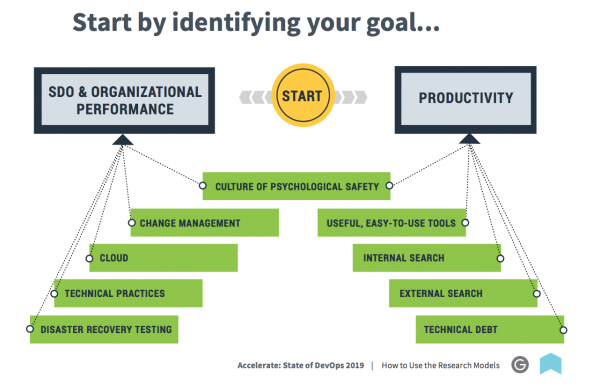The most effective strategies for scaling DevOps and fostering productivity include easy-to-use tools and solutions that create community, according to the 2019 Accelerate State of DevOps Report.
This year’s report, written by Dr. Nicole Forsgren, Dr. Dustin Smith, Jez Humble, and Jessie Frazelle, represents six years of research and data from more than 31,000 professionals and aims to better understand how the technical and cultural practices associated with DevOps affect team and organizational performance. It also explores ways to help improve performance and productivity and even reduce burnout.
Demographics
We’ll look at a few highlights of the report, but first it’s worth noting the demographic makeup of survey respondents, most of whom work within the tech industry (38%), followed by financial services (12%), retail/consumer (9%), and other.
“Gender breakouts from this year’s survey responses remain consistent with 83% male in 2019 (vs 83% last year), 10% female (vs 12% last year), and <1% non-binary (vs <1% last year),” the report states. However, this year’s respondents said that only 16% of their teams include women, which is down from 25% reported last year.
The number of respondents who work as part of specific DevOps/SRE teams has stayed at approximately 27% for the past three years; 30% are part of Development or Engineering. Additionally, the breakdown of operating systems used has been fairly consistent:

Improving performance
The report notes that many organizations are looking for a specific set of best practices for adopting DevOps, but every organization differs in terms of technology, culture, processes, and goals. Thus, taking a more general, or holistic, approach—through which you first understand and describe your existing processes and desired outcomes and then empower teams to accomplish those goals—can be most effective.
“Remember that our goal is improving our ability to deliver software, which we accomplish through technical practices in delivery and deployment we call continuous delivery (CD). CD reduces the risk and cost of performing releases. Continuous delivery for the sake of continuous delivery is not enough if you want your organization to succeed, however. It must be done with an eye to organizational goals such as profitability, productivity, and customer satisfaction.” — 2019 Accelerate State of DevOps Report
This year’s report aims to help organizations drive improvement in both performance and productivity using two research models, shown below, and it offers guidance depending on what you want to improve.

Fostering productivity
As defined in the report, “productivity is the ability to get complex, time-consuming tasks completed with minimal distractions and interruptions.” Productive people complete their work efficiently, giving them more time to do other things.

One way organizations can help foster productivity is through the use of appropriate tooling. This year’s findings showed that the highest performing engineers are one and a half times more likely to have easy-to-use tools.
The following image shows a breakdown of performance relating to use of open source, proprietary, and commercial off-the-shelf (COTS) software.

This section of the report focused mainly on tools used in deploying software through the CI/CD and test automation process and found that the following factors foster productivity:
- How easy it is to use the toolchain (including straightforward and easy interactions and operation).
- How useful the toolchain is in accomplishing job-related goals.
The report found that elite performers more frequently automate and integrate tools into their toolchains on almost all dimensions.
More resources
You can learn more about DevOps here on the Red Hat Developer blog.
Last updated: July 1, 2020